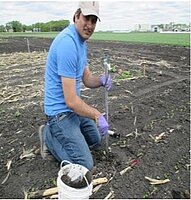Study On-farm Evaluation of Interactive Effect of Subsurface Tile Drainage, Tillage and Crop Rotation on Nitrate Leaching

Umesh Acharya is a Master of Science student in Soil Science program at North Dakota State University. He holds a Master of Science degree in Vegetable Sciences from Tamil Nadu Agricultural University, India and Bachelor of Science degree in Agriculture from Tribhuvan University, Nepal. His present research is focused on understanding the interactive effect of drainage, crop rotation and tillage on corn yield and residual inorganic nitrogen.
Fellow: Umesh Acharya
Advisor: Amitava Chatterjee, Ph.D., Assistant Professor, Department of Soil Science, North Dakota State University
Degree Progress: M.S. in Soil Science expected graduation in spring 2018.
Study On-farm Evaluation of Interactive Effect of Subsurface Tile Drainage, Tillage and Crop Rotation on Nitrate Leaching
Subsurface tile drainage is a common water management practice under Fargo clay soils. Nitrate N is mobile and, therefore, can be lost from the soil profile by leaching. Subsequent transport of nitrate N to surface waters occurs through subsurface drainage (tile lines) or base flow. Although tile drainage has many benefits it also may increase nitrate –N losses through the root zone and out to surface waters. Loss of nitrate through tile drainage depends on its interaction with amount of fertilizer N applied, crop rotation and tillage practices. Comparison of no-tillage with conventional tillage on below root zone nitrate concentration is critical to reduce the N loss through subsurface drainage. On the other hand, continuous corn has increased the amount of fertilizer N application intensity as compared to corn-soybean rotation. Finally, including control system under tile drainage also can reduce the N loss from the field. Our research goal is to understand the interactive effect of (i) tile drainage system, (ii) tillage and (iii) crop rotation on nitrate leaching loss through subsurface tile drainage system. Research objectives are (a) to study the effect of tile drainage system, tillage and crop rotation on nitrate leaching loss under tile drainage system. (b) to understand and estimate soil inorganic N content under different tile drainage, tillage and crop rotation.
Project Objectives:
The scope of proposed research is to understand the interactive effect of tile drainage system, tillage and crop rotation on nitrate leaching loss through subsurface tile drainage system. The specific research objectives are
- To study the effect of tile drainage system, tillage and crop rotation on nitrate leaching loss under tile drainage system. (In Progress)
- To understand and estimate soil inorganic N content under different tile drainage, tillage and crop rotation. (In Progress)
Progress:
Soil water samples using suction lysimeter were collected weekly from each plots after 28 days of planting. Water samples collected from inside lysimeter were analyzed for nitrate content using Ammonia analyzer. After corn and soybean harvest, soil samples were collected from each plot for measuring inorganic nitrogen content. Lab analysis of soil for total inorganic content is under progress. Based on the work done so far manuscript is under preparation to be submitted soon to a peer review journal.
Significance:
Tile drainage, crop rotation and tillage practices are key soil and water management components for sustainable corn and soybean production. The proposed study will give idea on the interactive effect of tile drainage system, different tillage method under rotation (continuous corn and corn soybean) in nitrate leaching and soil inorganic nitrogen content. Measure and understanding on nitrogen use efficiency will give information on how much to use nitrogen based fertilizer under different tillage system, tile drainage and rotation.

Amitava Chatterjee
AES School of Nat Res Sciences
Office: Walster 133 Telephone: 701-231-7858
Email: amitava.chatterjee@ndsu.edu


